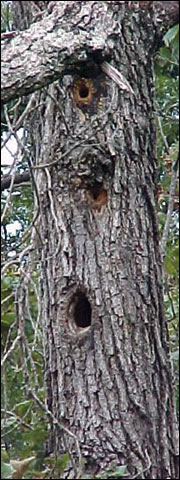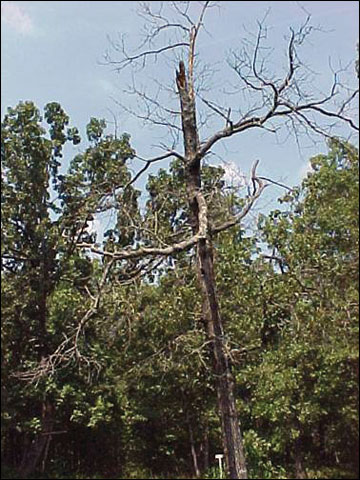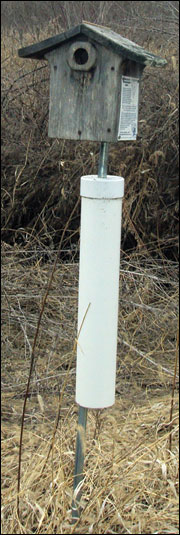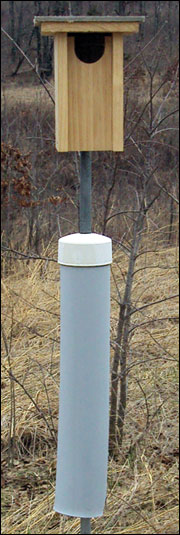Editor's note
The References section was updated in June 2017.
Many people enjoy having wildlife on their property and will manage their property to make it more inviting for specific species. Successful wildlife habitat management begins with identifying the habitat components (food, cover, water and space) of the species of interest that are in shortest supply and then providing them.
Suitable cover is often one of the most limited habitat components on a farm or in a residential area. For example, more than 80 wildlife species in Missouri use cavities in den trees or snags for nesting and denning cover. Snags (standing dead trees) and den trees (live trees with a cavity in the trunk or limbs) provide essential food and cover for many wildlife species in woodland habitats but are not often retained in forest management activities or in many new residential area (Figure 1). New residential developments seldom have many trees and what trees they generally have (Bradford pear, conifers, flowering crab apple or ash) do not favor the development of natural cavities. Natural cavities will form in native hardwoods such as oak and sycamore, but they take many years to develop.
Providing nest boxes while waiting for trees to mature can make these environments more habitable for cavity-nesting wildlife. Several wildlife species, including Eastern bluebirds, wood ducks and purple martins, have benefitted from the increased use of nest boxes. Although nest boxes are not a replacement for the habitat provided by hardwoods and other tree species, they can be used as a wildlife habitat management practice to supplement natural cavities and thus enhance a property's attractiveness to cavity-nesting species, while complementing the landscape design. Figure 2 shows two bluebird nest box designs that have been successful. Note the predator guards that have been installed to prevent nest predators from entering the nest box.
Each wildlife species has preferences for the type and location of its nest cavity, some of which will overlap among species. Nest box plans and designs for most cavity-nesting wildlife species are available from a variety of sources, some of which are listed in the references section of this guide. The appearance of nest boxes may vary considerably, but their basic function remains the same: to attract the wildlife species of interest to your property.
A properly maintained nest box can last for years. To maximize its value, buy or build a nest box with the correct specifications for the desired species, and install it at the proper height and in the proper location — near food, water and other cover needed by the desired species. This guide describes how to select and install nest boxes that are most beneficial for the wildlife species you wish to attract to your property.


Figure 1. Den trees and snags provide important habitats and sources of food and cover for many wildlife species in Missouri.

 Figure 2. Predator guards prevent predators from invading these bluebird nest boxes.
Figure 2. Predator guards prevent predators from invading these bluebird nest boxes.
Size and location
Nest boxes are more likely to be used when chosen and placed according to the following criteria.
The size of the entrance hole is one of the most important factors that determine what species may use a nest box and what species can be excluded from it. For example, bluebird enthusiasts have discovered that a box with a long, narrow slit at the top rather than a round opening can be used by bluebirds but is unattractive to species such as house sparrows.
The size of the internal cavity is also important, possibly more important than the diameter of the entrance hole. In addition, the best placement of the cavity varies by species.
The location of the nest box should be based on the requirements of the wildlife species you want to attract. You will need to consider the following questions:
- Is the nest box placed at a height that will encourage the species to use it?
- Is the cavity protected from predators?
- Does the nest box get the proper amount of sun or shade?
- Is the nest box located near other habitat requirements: food, water and escape cover?
The arrangement of boxes with one another can also be important. For example, purple martins prefer nest boxes that are clustered, so apartment houses or groups of gourd nests often work well for them.
Table 1 provides nest box recommendations for some common Missouri wildlife species that require cavities. The references section provides sources of specific designs and detailed information.
Table 1. Nest box specifications.
| Species | Entrance hole diameter (inches) | Hole distance above floor (inches) | Floor dimensions (inches) | Box height (inches) | Height above ground (feet) | Start of nesting season (average) | Location tips |
|---|---|---|---|---|---|---|---|
| Birds | |||||||
| American kestrel | 3 | 10–12 | 8x8 to 9x9 | 14–16 | 10–30 | Mid-march to April | In orchards or pastures or near grassy habitats; face south or west; space at least ½ mile apart. Place 2–3 inches of wood chips on box floor. |
| Bluebird | 11/2 or 11/4 vertical slit or round hole | 6–7 | 4x4 | 11–12 | 3–6 | March to early April | In open fields, orchards or pastures; face north or east; space 100 yards apart. |
| Chickadee | 11/8 | 6–7 | 4x4 to 5x5 | 9–12 | 5–15 | Late April to early May | In 40–50 percent sunlight in hardwood forests, woodlots or yards with mature trees; one box per 10 acres. Place 1 inch of sawdust on box floor. |
| House wren | 11/8 | 6–7 | 4x4 to 5x5 | 9–12 | 5–10 | Late April to May | Under building eaves or in trees; can be free-hanging. |
| Carolina wren | 11/8 | 6–7 | 4x4 to 5x5 | 9–12 | 5–10 | Mid-March to April | In mature hardwood forests, forest edges, yards with mature trees. |
| Tree swallow | 13/8 | 6–7 | 4x4 to 5x5 | 9–12 | 4 | Late April to May | In open fields near water, pastures or wooded wetlands; on a post in open areas near tree or fence; face east ; space 30–100 feet apart. |
| Wood duck | 4 wide x 3 tall | 18 | 7x8 | 24–26 | More than 20 in trees; more than 3 above high water mark on posts in water | Late April to early May | In forested wetlands, swamps and ponds; place in deciduous trees 30–100 feet from nearest water. Place 4 inches of wood shavings on box floor. |
| Purple martin | 21/8 | 1 | 6x6 | 6 | 8–20 | Late April to May | In open areas at least 40 feet from trees near utility wires and open water. Paint white. |
| Screech owl | 21/2–4 | 10–12 | 6x6 to 8x8 | 15–18 | 10–30 | Late March to April (will use year-round) | Edges of mature hardwood forest, wooded parks or stream edges. Place 2–3 inches of wood chips on box floor. |
| Mourning dove | Shallow cones or nest baskets | – | 12 | – | 6–16 | February to March | In moderate shade in the crotch of a horizontal tree limb. |
| American robin | On shelves | – | 7x7 to 8x8 | – | 6–10 | Late April to May | In sheltered sites under eaves or soffits, or in tree trunks. |
| Barn owl | 10x10 | 8 | 18x22 | 18 | As high as possible | May nest during any season | In barns or buildings or high on tree trunks in rural areas near open grasslands and crop fields; face opening toward barn wall. Place 2 inches of wood shavings on box floor. |
Mammals | |||||||
| Bat | 1 (between dividers) | – | Variable | Variable | 12–15 | Early April | Attach to tree trunk, side of building or post; face east on sites protected from the wind. |
| Southern flying squirrel | 11/4 | 6 | 4x4 to 5x5 | 9–12 | 10–30 | February to March (will use year-round) | In heavily wooded sites; locate hole on side of house close to tree trunk. |
| Gray and fox squirrel | 3 (on side, 21/2 inches from tree) | 10–12 | 6x6 to 8x8 | 15–18 | 10–30 | In trees of at least 10 inch diameter in woodlots or backyards; face east or south. Fill half full with dry leaves. | |
Basic design tips
Keep the following tips in mind when building or selecting a nest box.
- Use quality, weather-resistant materials. Exterior grade plywood and lumber are good choices. Cedar and other rot-resistant woods are best to use. Avoid using treated lumber and metal.
- Do not paint or stain the inside of a nest box. Painting the outside, however, can prolong the life of the box and make it attractive for some species, such as white houses for purple martins.
- Slope the roof and make it extend over the sides of the box to allow water runoff.
- Drill at least four 3/8-inch drainage holes on the floor.
- Ensure the roof or one side can be opened to allow easy access for cleaning.
- Do not install perches. Natural cavities don't have them and neither should a nest box. Perches allow European starlings and English sparrows, nonnative invasive species, to harass cavity-nesters and eventually take over the nest box.
- Leave gaps or drill 5/8-inch holes (at least two per side) for ventilation near the top of each side.
- Erect the nest box well before the average start of the nesting season because some species set up a nesting territory three to four weeks before laying eggs.
Maintenance
After the nesting season, clean out the old nesting materials. Although some species prefer to build a new nest on top of old nests, cleaning out the box helps minimize parasite infestations and makes the box less attractive for deer mice and other rodents that can exclude bird use the following spring. If unexpected residents occupy a nest box, you may need to install additional houses. Nest boxes for year-round residents such as screech owls and gray squirrels may be used throughout the winter.
Discouraging problem species
Vigilantly watch for house sparrows and European starlings in nest boxes. Competition by these species has been a leading factor in the decline of Eastern bluebirds. The proper diameter for the entrance hole will exclude starlings (1-1/2 inches or less) and house sparrows (1-1/4 inches or less) from nest boxes.
If you find starlings or house sparrows using a nest box, remove the nest and all of its contents again and again until they abandon the box. Although these species will likely rebuild their nests, house sparrows will often abandon their attempts to nest after repeated destruction of their nests.
Another way to discourage problem species is to close the entrance holes of the nest box until the expected arrival time of the target species that is not a year-round resident.
Discouraging predators
In Missouri, raccoons and house cats are the main predators from which nest boxes need protection. Many nest box designs include predator guards that prevent nest predators from enlarging the entrance hole or reaching into the box. For additional protection, install structures that prevent predators from climbing to the nest box. Generally, nest boxes on trees are easier targets than those mounted on poles. A cone or metal band can inhibit cats and raccoons from climbing trees or poles. When mounting inverted cones or other predator guards, be sure to place them high enough on the pole or tree that predators cannot leap above them.
Enjoying the view
If locating a nest box in your backyard, be sure to erect it in an area that allows you to easily view the activity. Evaluate whether the nest box is being used and whether it is being used by the desired species. If not, reconsider the nest box design and placement, and evict unwanted residents.
References
- Cornell Lab of Ornithology NestWatch. http://nestwatch.org.
- Missouri Department of Conservation. Wildlife Management for Missouri Landowners . https://mdc.mo.gov/your-property/improve-your-property/wildlife-management.
- Missouri Department of Conservation. Woodworking. https://nature.mdc.mo.gov/discover-nature/activities/woodworking.
- University of Missouri Extension. G9460, Bats of Missouri: Information for Homeowners. https://extension.missouri.edu/g9460.
- University of Missouri Extension. G9439, Biology and Management of Wood Ducks in Missouri. https://extension.missouri.edu/g9439.